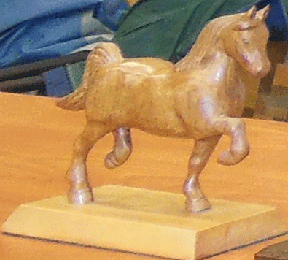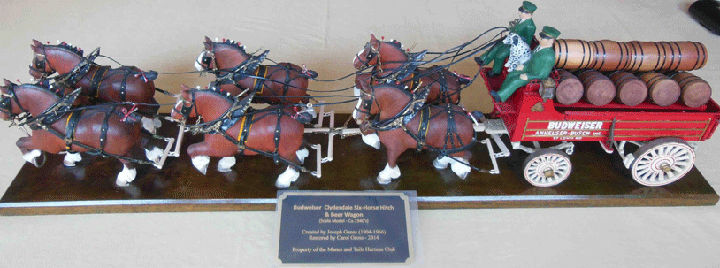
The Manes and Tails Harness Club received a gift of a scale-model
Budweiser Clydesdale six-horse hitch and beer wagon from Terry Avent and Sharon Hoffeman Avent of
Hastings, MN. The Avents had received the
hitch from the daughter Joseph Ganas of West St. Paul, the original artist,
a number of years after his death.
Significance of this Folk Art Piece
Upon doing some historical research, the Clydesdale six-horse hitch and red beer wagon is a
scale model (1:14) replica of the original six-horse hitch that was presented to
August A. Busch, Sr., by his son, August A. Busch Jr., on April 7, 1933,
following the repeal of prohibition. The event took place near the Anheuser-Busch Brewery in St. Louis, MO.
From that point on, Clydesdales have been the living symbol of the Anheuser-Busch
Brewery. A photo of the original
Clydesdale hitch and a description of the event was found in the book “All the
Kings Horses” 1.
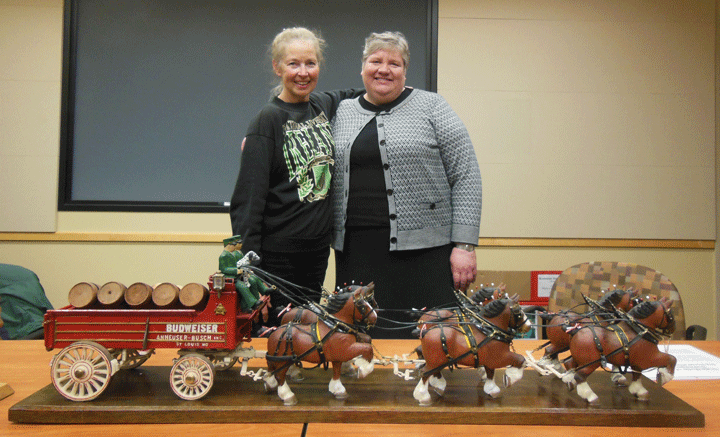 |
Carol Gross (left- harness and paint restoration and addtion of barrels) and Leslie Nielsen (right - granddaughter of Joseph Ganas, original artist) at the Manes and Tails Harness Club presentation on May 7, 2014. |
Original
Artist
The original artist and craftsman, Joseph Ganas (1904-1966) grew up in St. Paul, and moved to West St.
Paul when he married in 1928. Joseph was a roofer who did wood carving and metal work as a hobby. He spent as much time as he could in
the horse barns at the Minnesota State Fair, and admired the Budweiser
Clydesdales. While he never owned
horses himself, his father drove a water wagon in St. Paul. He likely would have seen the original
Budweiser Clydesdale hitch at the Minnesota State Fair when it was on tour in the 1930’s and 1940’s.
Following is a quotation from Joseph's granddaughter, Leslie Nielsen of Hastings, MN, about her grandfather:
“My grandfather, Joe Ganas, was born in St Paul,
MN to German/Polish immigrants in 1904. His dad worked as a teamster,
delivering water around the city. My grandpa loved being around his dad's
team of horses and would find any excuse to be with his dad at work. I
believe this team of horses would have been the only horses Grandpa was exposed
to as a young boy. But as he grew up, he found every possible opportunity
to be with all breeds of horses and spent every day of the State Fair in the horse
barns around the people and creatures he most loved. He spent his work
life as a roofer, but his passion was horses. He carved many beautiful
horses and gave them as gifts. A good number of these horses were carved
from wood and then finished with a simple varnish. Others were painted in
an amazingly life-like way. He painstakingly attached real horse hair as
manes on these painted horses. The Budweiser hitch was a one-of-a-kind
endeavor and took him several years to complete. He lived his adult life
in West St Paul. He and his wife, Elsie, had one daughter (my mother),
Janet. Grandpa was also a great artist, working primarily with pen and
ink and pencils. His early artistic skills were noted by the nuns at St
Adalbert's School (St Paul) and he was encouraged to continue drawing.
Grandpa died in 1966 after battling cancer. In his last months he was no
longer able to carve horses so many of his projects were left undone. I
recall as a child being even more fascinated by these half-completed works than
I was the finished products because it was so amazing to me that the horses
really did start out as just blocks of wood. He might have been able to
get more horses carved if I had not taken so much of his time! I was
often at my grand parents home for several days at a stretch and the moment he
got home from work, my day brightened as my favorite playmate was at my beck
and call! He was the kindest and most loving grandfather imaginable!”
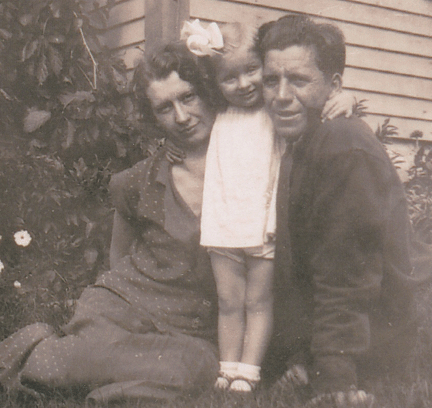
|
Left: Joseph Ganas with his wife, Elsie and daughter Janet (~1930)
Below: Single horse carving by Joseph Ganas |
|
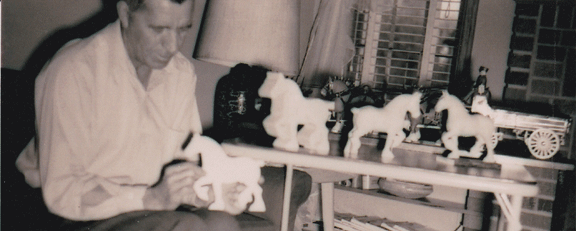 |
Left: Joseph Ganas with his Budweiser Clydesdale 6-horse Hitch and several hand-carved wooden horses in different stages of progress. |
Anheuser-Busch
History
1857 Adolphus Busch (18 years old) left Mainz, Germany to settle in St.
Louis, MO.
Early German immigrants established
breweries in the eastern states, and Milwaukee was the beer capital by the
mid-1800’s (including Miller, Pabst and Schlitz breweries). Newer immigrants including Aldophus
Busch had to move further west to compete in the beer industry.
1859 Busch established a brewery supply business with Ernst
Wattenberg. At age 21 he married Lilly Anheuser, daughter of a prominent St.
Louis businessman. Lilly’s father
asked Adolphus to manage a small brewery he had acquired. The brewery was located on Petalozzi
Street, near the Mississippi River. Adolphus was very promotion-minded, and by the early 1900’s
Anheuser-Busch brewery was the most successful brewery in the country.
In
the 1800’s, horses and mules were an important component of the beer
industry. They were used to pull
wagons that transported beer to market. The beer market was primarily the
taverns and saloons that were owned by the breweries. Taverns and saloons were the social centers of society at
the time.
Adolphus Busch felt strongly that it was
both humane and economical to house horses as comfortably as people. He had
found after working with hundreds of horses, that well-fed and well-treated
horses did more and better work than those that ate and slept in cold, damp,
dark places.
1873 Pasteurization was invented in 1871, and Adolphus
Busch saw great potential for expanding the distribution of his beer nationwide
by rail, since the beer could be stored much longer before spoiling. He started bottling beer in hand-blown glass
bottles with corks, and large-scale
advertising began. Additional
inventions that affected the beer industry were:
1898
– Automatic bottle blowing machines were invented
1910
- First crown cap bottling machines
1935
- First steel beer cans – not popular until WWII
- Golden
age of beer occurred after WWII
Full page newspaper ads, TV advertising,
sports events came into bars and homes via TV
1962
– First pull-tab cans
1913 August A. Busch,
Sr. took over management of the Anheuser-Busch brewery. He spent all of his
leisure time around horses, both riding and as a coach driver (whip). He loved
competition and would hold Sunday brewery horse turnout contests.
August
A. Busch, Jr., born in 1899, learned to ride early, and participated
in many equine activities, including, pack horse trips, calf roping
bronco-riding, team roping, polo, jumping fox hunting, steeple chase races, driving
Hackney, Fine Harness Horses and large breed 4-in-hand competitions.
August,
Jr. started working at the brewery, running the stable operations. He was particularly impressed by
Clydesdale horses, and authorized their purchase to join the Anheuser-Busch
fleet.
Clydesdale horses weight about
2000 lb and are 17 hands. They
were used for farming, in the lumber and beer industries, and they pulled fire
engines, and for transporting families and produce to town. The Clydesdale breed comes from the
fertile valley (dale) of the River Clyde in Scotland. The Clydesdale breed was founded in Scotland in 1877,
and the first Clydesdales were brought to the US in the mid 1800’s. The
American Clydesdale Breeders
Association was started in 1879.
1917 Gasoline-powered
trucks began to replace horse-powered vehicles in the early 1900’s, and by 1917 trucks were the primary transportation
used for beer.
1919 The 18th Amendment to the US Constitution was passed. Prohibition became law, and alcoholic beverages became
illegal.
Many
breweries (about 1500) closed, but Anheuser-Busch switched to products such as
yeast, corn, malt syrups, ice cream refrigerators, near beer, diesel engines,
animal feeds. to stay in business. After prohibition, only 164
breweries were still in business.
1933 Repeal of Prohibition took place on April 7, 1933. Minutes after midnight, the first
post-Prohibition beer came out of the Pestalozzi Street Brewery.
April 7, 1933 Clydesdale horses became the living
symbol of Anheuser-Busch. Other companies used draft horses to promote their
names and products. During
Prohibition, August Jr. saw an exhibition of Clydesdales (6-horse hitch) owned
by the Wilson Packing Company of Chicago. He decided to commemorate the repeal of Prohibition with a Clydesdale
hitch. So, he bought 8 Clydesdale
geldings and harnesses from Union Stockyards of Chicago. The horses were secretly moved to the
St. Louis Brewery stables, along with former Anheuser-Busch drivers Art Zerr
and Billy Wales.
Billy
Wales was one of the most famous drivers “whips” of his time. He had his hands insured for $50,000,
and one of his Clydesdales, Sir Hurbert, was the most photographed horse in
America.
Beer
Wagon – 1903 Studebaker meat wagon that were converted to deliver beer. Wagons have two braking systems: a hydraulic pedal device that slows the
vehicle for turns and descents down hills, and a hand brake that locks the rear
wheels when the wagon is at a halt. The original wagon cost $10,000 and weighed 3.5 tons.
As
a surprise for his father, August Jr. lured his father out of his office, into
the street in front of the brewery. At a prearranged signal, a 6-horse Clydesdale team appeared pulling
Budweiser beer wagon with Zerr and Wales in the driver seat. Records indicate that it was an
emotional event.
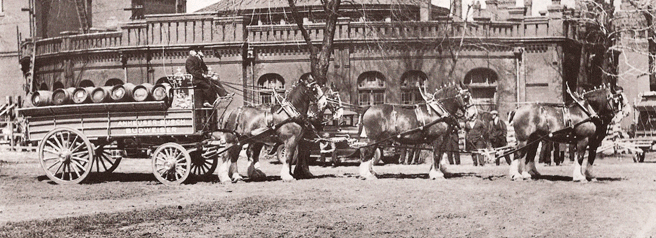
Original Budwieser Clydesdale Six-horse Hitch and Beer Wagon,
in front of the St. Louis Brewery in 1933
August,
Jr. realized the tremendous advertising potential of a horse-drawn beer wagon, and
had the team sent by rail to New York City. Wales trotted the 6-horse hitch through the Holland tunnel into
Manhattan. The team pulled up in
front of the Empire State Building, and presented the beer to former governor
of New York State, Al Smith, who had been instrumental in the repeal of
Prohibition.
The
team went on to tour New England and the Mid-Atlantic States, including Washington
DC, where they paraded down Pennsylvania Ave to the White to deliver of a case
of beer to President Franklin Delano Roosevelt.
A
second hitch of Clydesdale geldings was bought from the Wilson Packing Company. Both hitches were sent on tour to
places where Budweiser beer could most effectively be promoted. Promotion and publicity coordination
became well established.
Tours
were well planned with showroom facilities for public display (clean, inviting
appearance, water, electricity, good ventilation). They often used automobile showrooms. Photographers were hired to take
pictures.
Travel
of teams was initially by rail, and in 1940 truck transportation was
introduced. More recently,
customized tractor-trailers are used.
1940 A breeding program for Clydesdales was started at
the Anheuser-Busch farm to support three traveling teams. In 1955 a champion stallion, Balgreen
Final Command, was imported from Scotland. In 1966, 40 mares and a stallion
were imported from Scotland and Canada, forming the nucleus of the Clydesdale
breeding program. . The breeding
program resides at Grant’s Farm, the pre-civil war home of Ulysses S. Grant. It has been said that Clydesdales
survive in the US because of the Busch family’s support and promotion. In 1950,
Harry Truman visited Grant’s Farm.
Traveling
teams
1933
– Grant’s Farm in St. Louis, MO – serves the Midwest
1973
– Clydesdale Hamlet in Merrimack, NH – serves the east coast
1979
– Warm Springs Ranch – Romoland, CA – serves the wast coast.
1977 August A.
Busch III took over as Chairman of the Board of Anheuser-Busch, and
promotional activities of the Clydesdale teams. He moved the promotion into television and movies (including Hello
Dolly and Hardly Working).
Each
harness weighs 130 pounds.
Each
hitch employs a crew of 7 people: lead driver, assistant, 5 chauffeurs-grooms or horsemen.
Horses
never spend more than 4 hours/day in harness. While on the road, the handlers work MUCH more.
1982 Three Clydesdale hitches traveled 60,000 miles
making 300 appearances in the US, Canada and Puerto Rico, and also made TV
commercials, and were in movies like Hello Dolly.
Photographs
and paintings became a big part of the advertising, and started as early as
1933. Miniatures for window
displays were also used to promote Clydesdales as the corporate symbol.
Clydesdale
Six-Horse Hitch Model
The model had been stored for a number of years in the Ganas
family home, and was then given to the Avent family, many years after Joseph’s
death. While in storage, the hitch sustained water damage to the
finish on the wooden base and to some of the horses, and significant
deterioration of the harness leather had occurred. However, the wood used for base, for the beer wagon and for the
hand-carved horses, and the metal hardware were in good shape.
Kenn Kopitzke received the model from Terry Avent, and presented
the model at a club meeting, to decide what the club would like to do with the
display. It was decided that the individually
hand-carved wooden horses, and accurately, built-to-scale, wood and metal model
of the Budweiser beer wagon were definitely worth preserving and restoring.
Condition
Of The Model As Received By The Manes And Tails Harness Club
The finish on the front-half of the wooden base was significantly water damaged,
with almost no finished remaining. The finish on the back half of the base was in reasonable shape, and the
wood was in good shape. The lead
team of horses had almost no finish left, and the harness leather had leached black
stain down the legs. The wood
grain showed through the remaining stain, and the horses appeared to be carved
from oak. Each of the six horses
was carved in a slightly different pose. The stain or paint on the swing and wheel teams were in better shape,
but most of the harness had deteriorated, or would crumble when touched. None of the reins remained. The wagon was missing some paint and
part of the metal decoration on the side panels. The color of the uniforms of the driver and assistant were a
faded, olive-green. The brass hames, and studs on the harness were very
tarnished. Original leather used
for the tugs, bridles and one piece of saddle harness were of better quality
than that used for most of the harness, and were still holding together.
Model
Measurements
Clydesdale Horses
Height
= 5 inches at withers
Height
= 6.5 inches to tips of ears
Length
= 7.5 inches from nose to tail
Beer Wagon
Box
length = 12 inches plus 1.5 inch foot rest
Wagon
height = 7.5 inch + lamps = 8 inches
Wagon
width + wheels = 8 inches
Box
width = 5 inches, plus angled flange of 0.5 inch on each side of box
Box
height = 5 inch
Box
height plus flange = 5.5 inch
Wooden Base
Base
length = 42 inches
Base
width = 8 inches
Base
height = 1 inch
Attachment
Each horse is attached to the
wooden base with 2 bolts inserted into opposing legs and anchored to the board
with nuts in recessed spaces drilled into the bottom of the board.
Restoration Details
|




